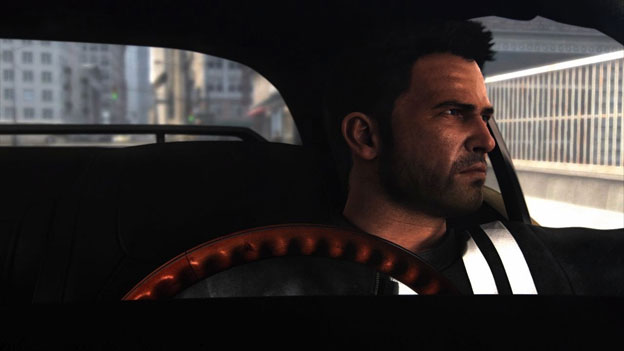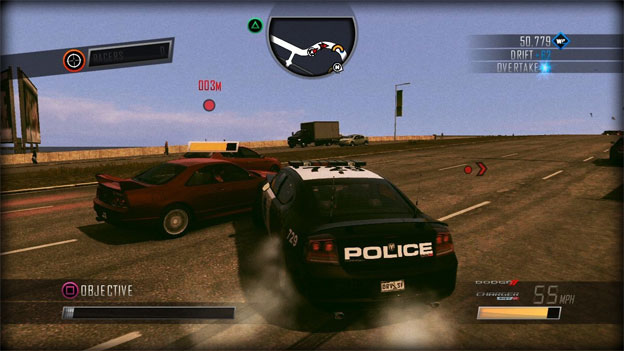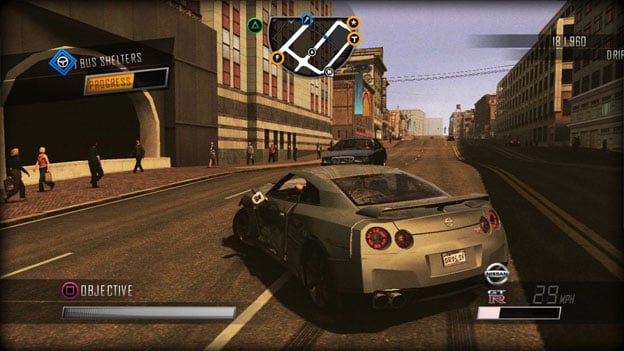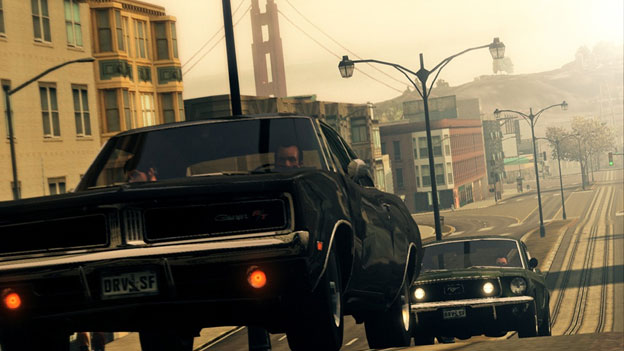California Cruisin’
I don’t normally play non-kart racers. They’re frustrating exercises in a type of precision I don’t possess. I don’t play destruction derby games, or anything in the Twisted Metal series, and my relationship with Interstate ’76 was less than friendly. Why, then, did I find myself getting up in the middle of the night to play a title that subtly mixes elements of these together under one awning?
The first thing that strikes you about Driver is its graphics. Specifically, they’re jarring. While the cars are accurate and gorgeous models of licensed vehicles, the animation and character models used in the CG cutscenes are awkward and look like plastic. They also run at a visibly lower frame rate than the game itself, a fact that is practically thrown in your face. Driver: San Francisco simply uses the game engine any time it needs to show you cars instead of people. It’s a minor nitpick, but it makes a bad first impression.

It’s all right, though—that first impression almost immediately gives way to (if you’re as poor a driver as I am) the realization that these licensed vehicles all take realistic damage. You can run over a VW Beetle in a tanker or crash a Chevy Volt into the side of an H3 and it’ll react realistically to the impact, glass flying everywhere, frame crumpling as the hood careens off onto the sidewalk. Even minor scrapes, which don’t actually decrease your car’s health, will leave scratches down its side or shatter its side-view mirrors, which then dangle uselessly by a few wires.
The visual spectacle is accompanied by appropriate auditory punch, with visceral crunching and splintering sounds, the wince-inducing shrieks of paint peeling off and a funk-infused licensed soundtrack, including a particularly awesome Diplo remix of Marlena Shaw’s “California Soul.”

But what happens when your car’s too broken to go on? That’s where the game’s “SHIFT” mechanic comes in. The absolute cornerstone of gameplay, SHIFT is Driver: San Francisco’s unique contribution to the genre. It allows players to instantly zip out of their car and see the city from above, zoom out to get a better lay of the land, then jump into any other car on the road. Any. Other. Car. There are occasional exceptions in races, such as opponents’ vehicles, and other players’ cars can’t be taken in multiplayer, but it’s largely an open thing. This allows for some lateral problem solving in single-player missions, and defines the multiplayer experience from top to bottom.
Before we touch on the mechanics of the campaign, though, we have to talk about its story. It’s short, ludicrous, and poorly acted. The script isn’t actually bad , but lines are delivered with inappropriate emphasis and some of the word choices don’t fit the characters who speak them. What makes the plot disappointing overall, though, is how little it does with its potential. Charles Jericho, during a prison break, puts detective John Tanner (that’s you) in a coma. The rest of the game? It’s Tanner’s coma dream. This is played for great effect both early and late in the game, but it just sort of fades into the background during the bulk of it all, which is too bad. There’s something entrancingly surreal about chauffeuring oneself to the hospital while inhabiting the ambulance driver’s body, seeing signs that urge Tanner to “wake up” or “do it again,” and one particularly haunting chase through the packed, but silent, streets of a frozen San Francisco.

The rest of the time, though, is spent on typical buddy cop shenanigans, as Tanner and his partner try to recapture the escaped Jericho and puzzle out the meaning behind an apparent terrorist attack. All of that time is spent getting involved in other people’s stories, and when Tanner wakes up, they’re completely forgotten with no payoff. It’s a lot of busywork that could have been given some real weight if the developers had been willing to make Tanner’s out-of-body experiences something more than a series of misfiring synapses.
But, disappointing though the arc may be, the missions themselves are often a blast. The SHIFT mechanic opens up unique possibilities, even in tasks that don’t directly call for it. Fallen too far behind in a race to ever hope to catch up? Possess a car in oncoming traffic and smash your competitors into the asphalt. Winning by default is still winning, after all. The campaign also gives Tanner a pair of extra abilities: boost and ram. Both draw from the same ability bar, which can be upgraded both in length and recharge speed, but, as long as you have the meter remaining to use them, you more or less have free rein. They’re rather self-explanatory, but it’s strange that only boost makes its way over to multiplayer.
Driver’s online experience offers a lot of variety, and some clear creativity on the part of its developers. Rather than racing and destruction derby variations, Driver: San Francisco offers games such as Capture the Flag and Blitz, in addition to various race types and a Takedown mode. Blitz is Driver’s most unique game type, in which one team must defend a base while the other team attempts to infiltrate it by crashing their cars headlong into it. The defenders merely have to tag their opponents to take them out of the game and score points, while the attackers simply have to squeeze past the defenders. SHIFT adds another layer of strategy to this, as defenders won’t always want to just sit in the base, but move out and catch attackers as they sweep in. Takedown is cops and robbers, in which the cops can possess any car on the road using SHIFT, making the robber’s life much more difficult as he tries to make a series of pick-ups around town.

In general, when one possesses the objective of a game type, that player cannot SHIFT, but everyone else is more than welcome to pop into other cars at any time. A flash of lightning announces the change. In the interest of balance, SHIFTing is limited by the ability meter, which is shared with boost. In addition, as players gain experience and level up, they unlock new cars, new modes of play and, perhaps most importantly, new abilities. These abilities allow one to change a car’s model after possessing it, spinning other players off the road from the SHIFT perspective, and spawning a car on the spot for one to inhabit. All such abilities use the weapon meter: a second bar that must be completely full before one may activate an ability
Most importantly, however, the multiplayer is smooth. I never once experienced lag of any kind and finding games was generally a painless process of choosing a game type and waiting a few seconds. It’s somewhat disheartening that the cars you purchase in the campaign don’t transfer over to the multiplayer, which makes the campaign’s extra challenges and dares seem all the more superfluous. However, it’s probably better for the sake of balance that the two are kept separate.
Driver: San Francisco is an entertaining gem from a series that had fallen into obscurity and stagnation. It strips away the “me-too” and gets to the core of what makes high-speed chases entertaining, with recognizable cars that handle realistically (but not too realistically) and distinctly, model damage in a viscerally satisfying manner, and offer an intoxicating sense of speed. The short of it: I don’t like racers, and I rarely like driving games, but Driver: San Francisco hit a sweet spot with its gameplay that had me continually coming back for more.
RATING OUT OF 5 RATING DESCRIPTION 4.0 Graphics
Though the character models are low-detail and jerkily animated, the real stars of the show, the cars, are painstakingly reproduced and their damage modeling is superb. 4.5 Control
Intelligently mapped controls make the game a matter of skill, and never one of luck. Cars handle logically and, by and large, realistically. 4.0 Music / Sound FX / Voice Acting
Though the voice acting is bad, the cars sound satisfying whether driving or crashing. The licensed soundtrack has more hits than misses. 3.5 Play Value
Once beaten, there’s really no reason to go back to the campaign except for the sake of completion. The multiplayer, though, will keep players coming back for more. 4.2 Overall Rating – Great
Not an average. See Rating legend below for a final score breakdown.
| Review Rating Legend | |||
|---|---|---|---|
| 0.1 – 1.9 = Avoid | 2.5 – 2.9 = Average | 3.5 – 3.9 = Good | 4.5 – 4.9 = Must Buy |
| 2.0 – 2.4 = Poor | 3.0 – 3.4 = Fair | 4.0 – 4.4 = Great | 5.0 = The Best |
Game Features:
